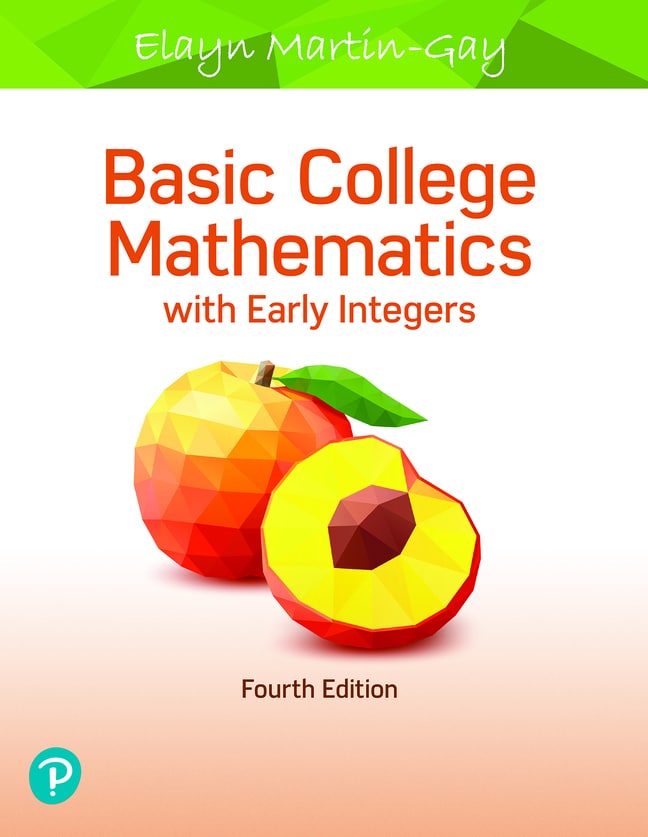
Basic College Mathematics with Early Integers, 4th edition
- Elayn Martin-Gay

- Watch and learn
Videos & animations bring concepts to life
- Listen on the go
Learn how you like with full eTextbook audio
- Find it fast
Quickly navigate your eTextbook with search
- Stay organized
Access all your eTextbooks in one place
- Easily continue access
Keep learning with auto-renew
Elayn Martin-Gay is known for her accessible writing style with built-in support, including an emphasis on study skills. In Basic College Mathematics with Early Integers, Elayn supports student success through her accessible writing style and tools to increase study skills. Features in the text and other learning resources help you reinforce concepts and tie skills together. End-of-chapter support helps you when preparing for a test. The 4th Edition updates exercise sets and applications throughout, adds new Getting Ready for the Test exercises, offers a new Key Concept and Activity Lab Workbook, and much more.
Published by Pearson (July 15th 2020) - Copyright © 2020
ISBN-13: 9780136881209
Subject: Developmental Math
Category: Basic Math or Prealgebra
- The Whole Numbers
- 1.1 Study Skill Tips for Success in Mathematics
- 1.2 Place Value, Names for Numbers, and Reading Tables
- 1.3 Adding Whole Numbers and Perimeter
- 1.4 Subtracting Whole Numbers
- 1.5 Rounding and Estimating
- 1.6 Multiplying Whole Numbers and Area
- 1.7 Dividing Whole Numbers
- Integrated Review – Operations on Whole Numbers
- 1.8 An Introduction to Problem Solving
- 1.9 Exponents, Square Roots, and Order of Operations
- Integers and Introduction to Variables
- 2.1 Introduction to Variables and Algebraic Expressions
- 2.2 Introduction to Integers
- 2.3 Adding Integers
- 2.4 Subtracting Integers
- Integrated Review - Integers
- 2.5 Multiplying and Dividing Integers
- 2.6 Order of Operations
- Fractions and Mixed Numbers
- 3.1 Introduction to Fractions and Mixed Numbers
- 3.2 Factors and Simplest Form
- 3.3 Multiplying and Dividing Fractions
- 3.4 Adding and Subtracting Like Fractions, Least Common Denominator and Equivalent Fractions
- Integrated Review – Summary on Fractions and Operations on Fractions
- 3.5 Adding and Subtracting Unlike Fractions
- 3.6 Complex Fractions, Order of Operations, and Mixed Numbers
- 3.7 Operations on Mixed Numbers
- Decimals
- 4.1 Introduction to Decimals
- 4.2 Adding and Subtracting Decimals
- 4.3 Multiplying Decimals and Circumference of a Circle
- 4.4 Dividing Decimals
- Integrated Review – Operations on Decimals
- 4.5 Fractions, Decimals, and Order of Operations
- 4.6 Square Roots and the Pythagorean Theorem
- Ratio, Proportion, and Measurement
- 5.1 Ratios
- 5.2 Proportions
- 5.3 Proportions and Problem Solving
- Integrated Review – Ratio and Proportion
- 5.4 Length: U.S. and Metric Systems of Measurement
- 5.5 Weight and Mass: U.S. and Metric Systems of Measurement
- 5.6 Capacity: U.S. and Metric Systems of Measurement
- 5.7 Conversions Between the U.S. and Metric Systems
- Percent
- 6.1 Percents, Decimals, and Fractions
- 6.2 Solving Percent Problems Using Equations
- 6.3 Solving Percent Problems Using Proportions
- Integrated Review – Percent and Percent Problems
- 6.4 Applications of Percent
- 6.5 Percent and Problem Solving: Sales Tax, Commision, and Discount
- 6.6 Percent and Problem Solving: Interest
- Reading Graphs and Introduction to Statistics and Probability
- 7.1 Pictographs, Bar Graphs, Histograms, and Line Graphs
- 7.2 Circle Graphs
- Integrated Review – Reading Graphs
- 7.3 Mean, Median, Mode, and Range
- 7.4 Counting and Introduction to Probability
- Introduction to Algebra
- 8.1 Introduction to Variables
- 8.2 Solving Equations: The Addition Property
- 8.3 Solving Equations: The Multiplication Property
- Integrated Review – Expressions and Equations
- 8.4 Solving Equations Using Addition and Multiplication Properties
- 8.5 Equations and Problem Solving
- Geometry
- 9.1 Lines and Angles
- 9.2 Plane Figures and Solids
- 9.3 Perimeter
- 9.4 Area
- 9.5 Volume and Surface Area
- Integrated Review – Geometry Concepts
- 9.6 Congruent and Similar Triangles
Appendices
- A. Tables
- B. Exponents and Polynomials
- C. Inductive and Deductive Reasoning